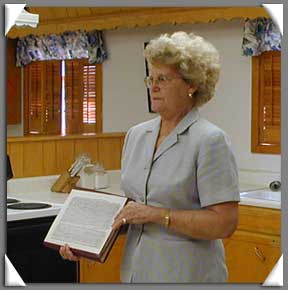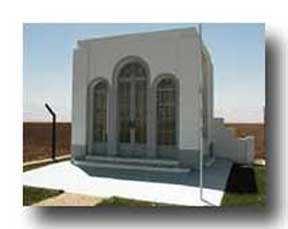 |
||||||||||||||||||||||
|
|
||||||||||||||||||||||
 |
||||||||||||||||||||||
| Clara Vick, of the Castro County Historical Society, talked about the Hereford Prisoner of War camp and chapel. The camp was open from 1942-1946. The prisoners were Italian people who were captured in North Africa and brought to the U.S. At one point, the camp housed seven thousand Italian prisoners. By 1945, the only remaining prisoners were those who refused to pledge their allegiance to the new Italian government. These prisoners built a thirteen-foot cube memorial chapel to commemorate the five men who died while imprisoned at the Hereford camp. Seven of the surviving prisoners were later escorted to St. Mary's Catholic Church at nearby Umbarger, Texas, to embellish the plain white interior. | ||||||||||||||||||||||
|
P.O.W. CAMP CHAPEL
This chapel is one of the few physical reminders of the days this site served as an Italian prisoner of war camp during World War II. The prisoners, several of them fine artisans and craftsmen, designed and built the chapel, crafting the concrete building to resemble marble. After the camp was closed and the land returned to the original owners, the chapel fell into disrepair. A restoration project, begun in 1987, was completed in 1989 and a historical marker was placed at the site. The State of Texas placed the marker in 1989, waiving its policy that structures must be standing for fifty years before being designated as historical sites, in recognition of the Italian former POWs who were still living and who wished to see the dedication. As part of the restoration, the chapel is now surrounded by a fence made of barbed wire left from the original compound, although the cemetery was originally outside the camp. |
||||||||||||||||||||||
 |
||||||||||||||||||||||
| In late summer 1945, as the Nons (non-collaborators) recognized that the war was wrapping up and they would soon be leaving, they began to think of the five prisoners who had died while at Camp Hereford. What would become of these men after the war? They almost certainly would be forgotten in the otherwise unmarked area east of the camp designated as the cemetery. They concluded that a memorial was needed, both to mark the gravesites and to serve as remembrance of their deceased friends. Using scavenged bricks, broken glass, surplus materials, and a few purchased supplies, they built a small chapel in just a couple of weeks, complete with an altar, double French doors, stained-glass windows, and a marble-like concrete surface. They dedicated it with a plaque reading:
I prigionieri italiani ai compagni che non terneranno. [The Italian prisoners to the companions who will not come back.] |
||||||||||||||||||||||
 |
||||||||||||||||||||||
|
Dedicated to
to the memory of the five Italians for whom their comrades built this chapel. Bodies re-interred Fort Reno, OK. 1947 Innocente Ortelli |
||||||||||||||||||||||
 |
||||||||||||||||||||||
| The watertower is still standing at the site of the Hereford POW camp. Other than the chapel, this is the only visible reminder of the camp, officially known as the Hereford Military Reservation and Reception Center. | ||||||||||||||||||||||
|
|
||||||||||||||||||||||
 |
||||||||||||||||||||||
 |
||||||||||||||||||||||
 |
||||||||||||||||||||||
| To view St. Mary's Church in Umbarger | ||||||||||||||||||||||
 |
||||||||||||||||||||||